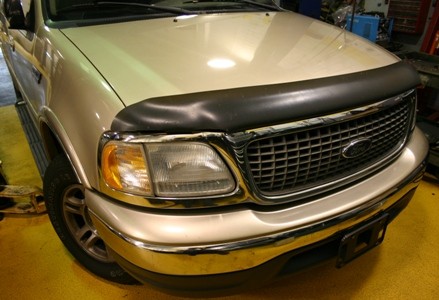The OBD2 code P0401 on a 2000 Ford Expedition, indicating “EGR Low Flow,” can be frustrating, but it doesn’t automatically mean you need a new EGR valve. Before jumping to conclusions and costly replacements, let’s explore the common culprits behind this code and how to effectively diagnose the issue.
Understanding the P0401 Code and Your Ford Expedition
When your 2000 Ford Expedition’s check engine light illuminates and you retrieve a P0401 code, the engine control module (PCM) is signaling that it’s detected insufficient exhaust gas recirculation (EGR) flow. The EGR system is crucial for reducing harmful NOx emissions by recirculating a portion of exhaust gas back into the intake manifold, lowering combustion temperatures. “Low flow” means this process isn’t happening efficiently, but pinpointing why requires further investigation.
The DPFE Sensor: A Frequent Culprit
For 2000 Ford Expeditions, and many other Ford, Lincoln, and Mercury vehicles, a very common cause of the P0401 code is a faulty Differential Pressure Feedback EGR (DPFE) sensor. This sensor plays a vital role in monitoring the EGR system’s performance. The DPFE sensor measures the pressure difference across the EGR orifice and sends this data to the PCM. The PCM uses this information to ensure the EGR system is operating correctly.
These DPFE sensors are often located near the EGR valve and are exposed to harsh exhaust environments. Over time, they can fail due to corrosion and carbon buildup. Interestingly, the original DPFE sensors on 2000 Ford Expeditions were made of aluminum, which, while not rusting, is still susceptible to corrosion. The updated replacement sensors are made of plastic, a design improvement, but failures are still common due to the demanding operating conditions.
Clogged EGR Passages: Another Common Issue
Besides the DPFE sensor, another frequent cause of P0401 on a 2000 Ford Expedition is blocked EGR passages. Carbon deposits can accumulate within these passages over time, restricting or completely blocking the flow of exhaust gas.
EGR passages visible with throttle body removed, showing potential blockage points.
Close-up view of EGR passages heavily restricted by carbon buildup.
In the images above, you can see examples of severely clogged EGR passages on a Ford Expedition. These passages, typically located beneath the throttle body, can become completely obstructed with carbon deposits, preventing proper EGR flow and triggering the P0401 code.
Diagnosing and Addressing the P0401 Code
When faced with a P0401 code on your 2000 Ford Expedition, follow these diagnostic steps:
-
Inspect the DPFE Sensor: Visually examine the DPFE sensor for any signs of damage or corrosion. Check the electrical connector for proper connection and corrosion. Consider testing the DPFE sensor with a multimeter if you are comfortable with electrical testing.
-
Check EGR Passages: If the DPFE sensor appears to be functioning correctly, the next step is to inspect the EGR passages for blockage. This often requires removing the throttle body to gain access. Use a mirror and flashlight to visually inspect the passages for carbon buildup.
-
Clean EGR Passages: If the passages are clogged, carefully clean them using carburetor cleaner or fuel injection cleaner, along with tools like a coat hanger or small brushes to remove the carbon deposits. Compressed air can be helpful to blow out loosened debris.
-
Inspect DPFE Hoses: If your 2000 Ford Expedition uses rubber hoses connected to the DPFE sensor, inspect them for cracks, deterioration, or blockage. If necessary, replace them with proper high-temperature DPFE sensor hoses.
-
Consider DPFE Sensor Replacement: Given the high failure rate of DPFE sensors on these vehicles, especially if the original aluminum sensor is still in place, replacing the DPFE sensor is often a worthwhile step, particularly if cleaning the passages doesn’t resolve the P0401 code.
-
EGR Valve (Less Likely): While less common, the EGR valve itself could be faulty. You can test the EGR valve by applying vacuum while the engine is running to see if it causes a change in idle. However, address the DPFE sensor and EGR passages first, as they are more frequent causes of P0401.
Conclusion
The OBD2 code P0401 on a 2000 Ford Expedition is frequently related to issues with the DPFE sensor or clogged EGR passages, rather than a faulty EGR valve itself. By systematically diagnosing these components and addressing common problems like DPFE sensor failure and carbon buildup in the EGR passages, you can often resolve the P0401 code and restore your Ford Expedition’s EGR system to proper working order. Remember to prioritize checking the DPFE sensor and cleaning the EGR passages before replacing the EGR valve to save time and money on unnecessary repairs.
